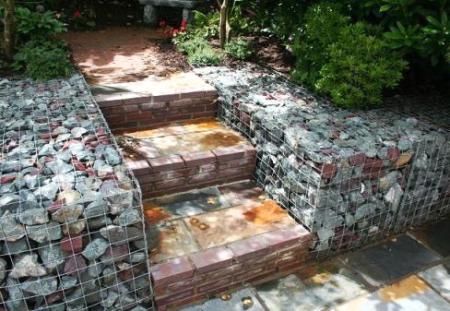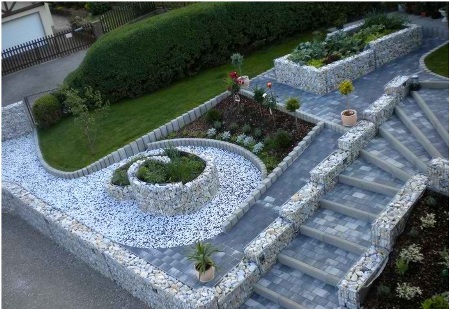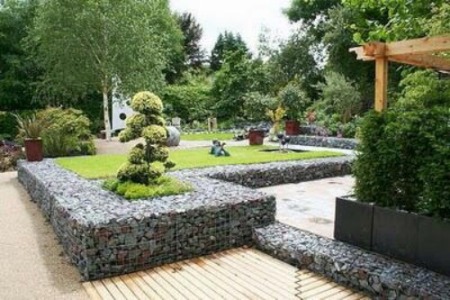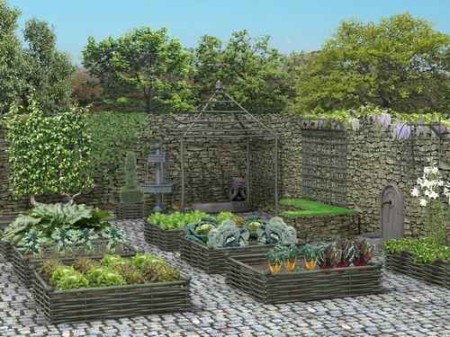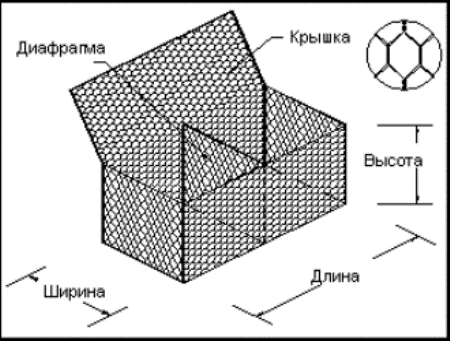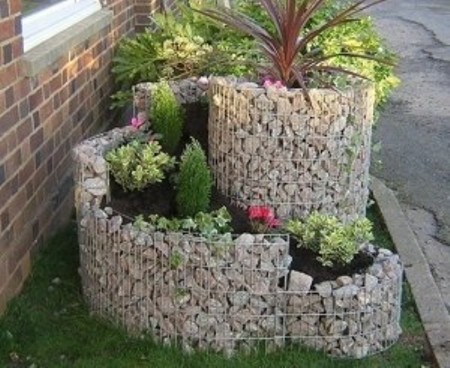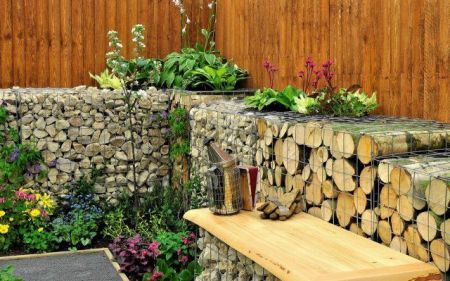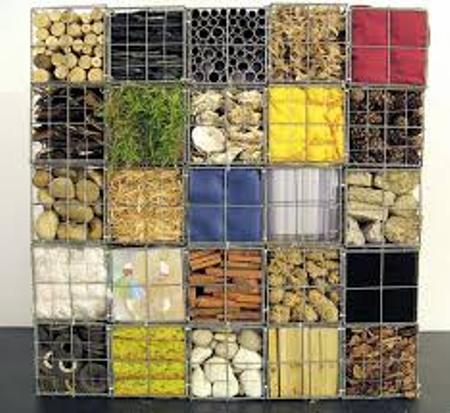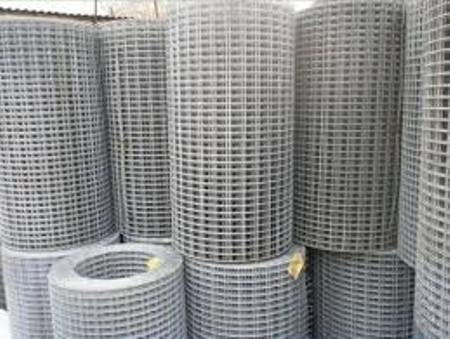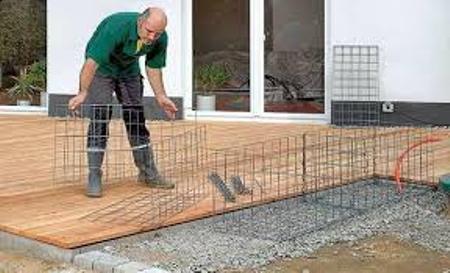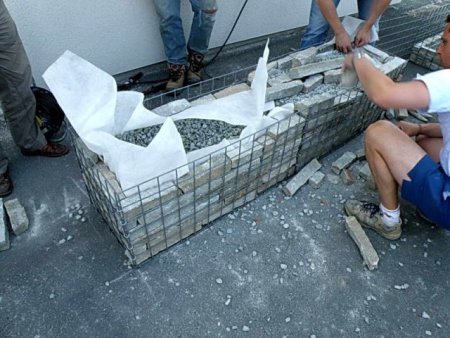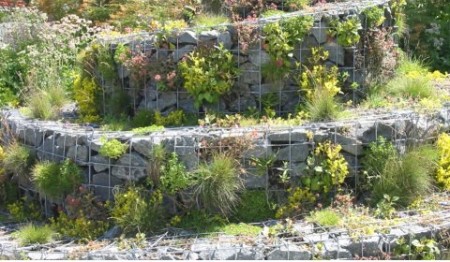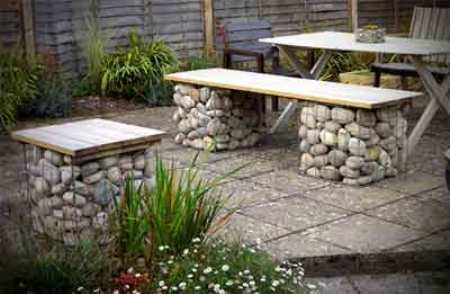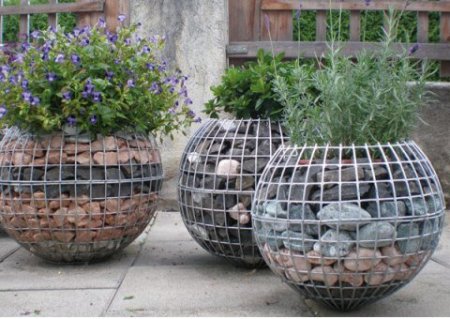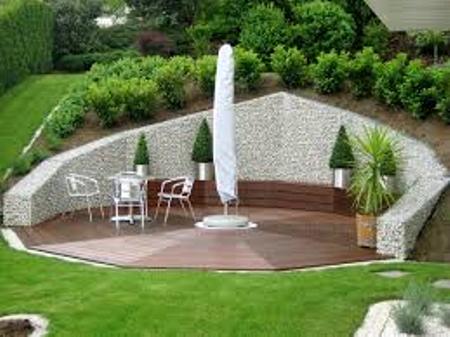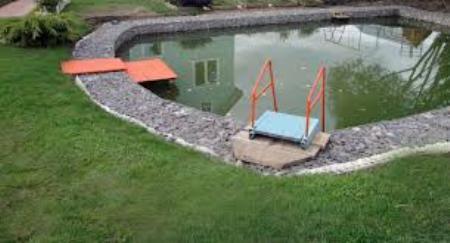Several years ago, original garden designs made of stone encased in metal wire containers were introduced into fashion. Fill the containers directly at the site where they are decided to install. In ancient times, fortified redoubts were built on this principle, but today gabions are used for perfect peaceful purposes - to form a shoreline of reservoirs, to create retaining walls, to strengthen slopes or simply as a decorative element, to give a more original look to landscape design.
Content
- 1 What materials can be used to make gabions
- 2 What are the advantages of the wire mesh
- 3 Varieties of gabions
- 4 Gabions - where and how are used
- 5 The stone for gabions is chosen correctly
- 6 The device of gabions - we carry out the installation ourselves
- 7 Several ideas on the use of gabions in the creation of landscape design
What materials can be used to make gabions
It should immediately be noted that gabions are rarely created by their own hands, they are more often satisfied with already prepared metal nets of a suitable factory-made form. To decorate the garden with gabion or to create a fence from it, it will be enough to install the finished structure in the chosen place and fill it with prepared bulk material.
There are quite a few attractive ideas for creating a garden landscape with the use of gabions. Use a ready-made project on the site is not difficult, creating your own, original version will require more effort. Those who decided to create gabions with their own hands, a step-by-step instruction will be required.
First, let's see what materials are used for work. To create the grid, galvanized wire is required, with a coating density of 250 to 280 g / m 2, this figure is 5 times higher than the density of galvanizing zinc, commonly used in the construction of fences.
Even better, if the wire will have a PVC coating. The wire thickness should be from 2 to 6 mm. Strength of containers attached a special technology for their creation, consisting of double torsion. The shape of the cell of such a gabion grid is a regular shape polygon. Depending on the size of the cell, stones, gravel, pebbles of a certain fraction are selected. In order to ensure that during the loading of the filler there is no protrusion of the walls, additional sectional compartments are equipped to create larger gabions.
The connection of individual sections is accomplished by a wire, and as a connecting it is desirable to use a wire of a different kind than that from which the sections are made. The materials used must be of high quality, otherwise the finished object can be deformed or even destroyed.
What are the advantages of the wire mesh
The metal mesh frame has many positive properties:
- installation of the frame can be done on any surface, the flexibility of the metal walls will ensure its close application to the ground,
- gabion structures are not affected by seasonal soil movements, even if there is a slight deformation, it will not threaten the destruction of the structure,
- stone filler of gabions makes them completely permeable for water, which relieves the structure of hydrostatic loads, the positive is the moment that the arrangement of drainage and drainage systems is not required,
- in the process of exploitation, the stability of gabion structures increases - between the stones a certain amount of soil accumulates, between them the roots of grasses germinate, which also strengthens the structure,
- installation of gabions is carried out without the use of special equipment, except for large-scale projects for the formation or strengthening of the shoreline of reservoirs,
- interference in the ecological system when installing gabions is minimal,
- a long service life of the structures provides quality galvanized wire and natural stones that do not suffer from changes in temperature and precipitation,
Gabions, the instruction for the construction of which has been fully taken into account, will not require additional maintenance or maintenance in the operation. The cost of building gabions is much lower than that of reinforced concrete structures, labor costs will be lower.
Varieties of gabions
By the form gabions can be:
- box-shaped,
- cylindrical,
- flat.
Accordingly, the skeleton shape will be a cylindrical, planar shape or box-shaped, it can be made of a mesh or be welded. The latter involves the welding of rods laid in a perpendicular direction relative to each other, at the points of intersection. The shape of the welded boxes is rectangular, and a wire helix is used to connect the walls.
Mesh structures are created by attaching the steel mesh to a rigid frame. The cell of such a grid has the shape of a hexagon.
The dimensions of box-shaped gabions can be different:
- 2- 6 m in length,
- 1 - 2 m wide,
- 0.5 - 1 m in height.
As already mentioned earlier, larger structures should be equipped with dividing dividers-diaphragms.
Gabions - where and how are used
The field of application of gabions is quite wide. They can protect the beds and flower beds, rectangular structures can be used as sections of a fence, in combination with wooden sections they have a rather attractive appearance.
Flat gabions up to 30 cm high are usually used:
- for lining the bottom of ponds and streams,
- they draw up a coastline, in particular having bends and an uneven surface,
- they are suitable for upgrading slopes of ravines and recreation areas.
The ideal filler in such cases is pebbles.
The robust design of the gabion allows it to be used as a foundation for a box structure. Cylindrical forms, having sufficient flexibility, are used for the construction of underwater foundations and retaining walls.
Examples of using gabions:
The stone for gabions is chosen correctly
Carry out the choice of stone should be given the location of the gabion - in water or on land. You can use natural or artificial, roughly detailed stones. Consider the shape, size and composition of the stones. Designers often use hard rocks: basalts, granites, quartzites, diorite, sandstones, which are resistant to temperature changes.
Decorative gabions can be filled:
- fragments of shingles or pieces of concrete,
- broken glass or trimmings of pipes,
- fragments of paving slabs or brick fighting.
It should be noted that the decorative effect of the structure will be influenced by the color, shape and dimensions of the fillers used.
As for the size of the stone, for ground gabions it is recommended to use a fraction whose length is 1/3 larger than the cell size, for underwater ones, with a length of 1, 5 cell size.
More naturally, the landscape will be filled with gabions filled with stones mined in the area. Gabions filled with large gravel or pebbles, rounded boulders will look unique and attractive.
To emphasize the originality and beauty of the gabion and the texture of its walls, it is recommended to install it on a lawn or in the immediate vicinity of it, or near a concrete or asphalt track having an even surface.
The device of gabions - we carry out the installation ourselves
Before you start, you should stock up:
- metal spirals and a grid,
- wire clips and pins,
- braces, geotextiles,
- stones, sand, other loose building materials.
Check their availability in advance, otherwise you may have to stop work.
The connection of the blocks from which the gabion will consist is performed using a metal spiral and staples, while it should not be forgotten that one side of the block must be opened, it will serve as a roof, the filler will be filled through it. Its fastening can be performed only after the filling of stones or other filling materials.
The fastening of the assembled boxes to the ground is carried out with the help of metal staples.
Backfilling of the stones is carried out as follows: first fill the box to half, pull the opposite sides with braces (wire ropes) - to prevent bulging of the panel walls. The number of braces is calculated in such a way that they are placed every 4-5 cells.
Having completed the creation of a sufficient number of stiffeners, the container is filled with crushed stone or stone filler. To reduce the number of large stones of expensive rocks, you can go for a little trick: the thoroughbred stones should be placed only on the bottom of the tank and used for waving the faces of the gabion. The middle of it can be lined with geotextiles and filled with small gravel or brick bricks, broken tiles. Backfill is performed to such a level that the fine filler can be covered with geotextile, and on top of it lay a layer of stones or large gravel. After making sure that the stones are laid pretty beautifully, the lid of the filled block is secured with a wire spiral.
Several ideas on the use of gabions in the creation of landscape design
Using gabions it will be easy to diversify the relief of the site and create artificial heights or lowlands on it, they will allow you to break original flower beds, create streams with waterfalls, beautiful lakes.
Unusual garden furniture for the recreation area can be created using a boxed gabion as a pedestal for the table. The stone base is perfectly combined with the wood from which the table top is made. In the same way, benches are made.
The original fencing for the flower bed can be created by erecting a cylindrical gabion. Flowers for planting on such a flower bed should choose the most juicy and bright colors.
The retaining walls made of gabions can become a real decoration of the site, in particular if they have an intricate, curved shape, the benches of the original design will look great near them.
Decoration of the banks of the reservoir can also be carried out with the help of gabions, an interesting addition to the stone structures will be wooden components, stone, forged parts.
You can see interesting ideas on the video:



